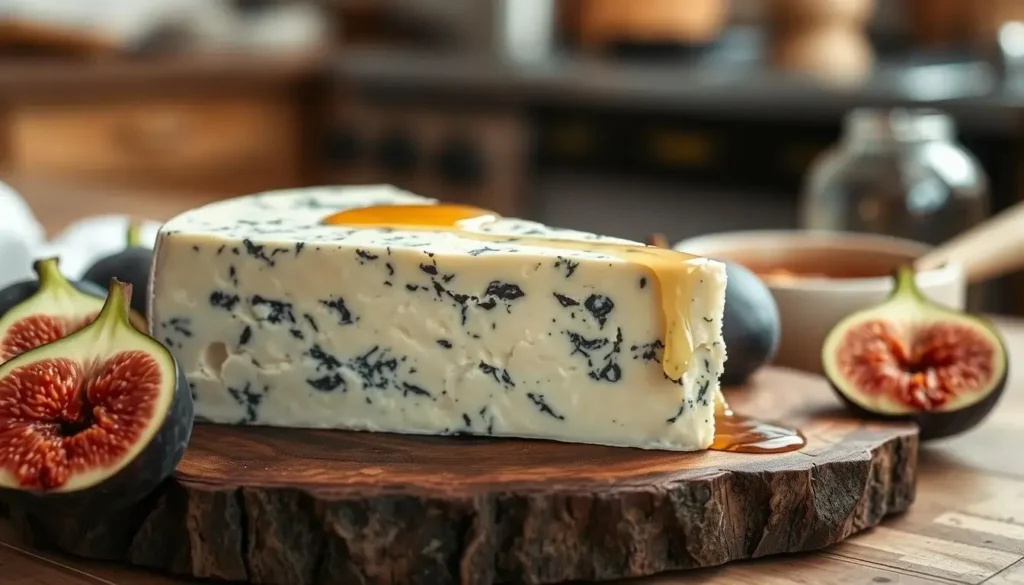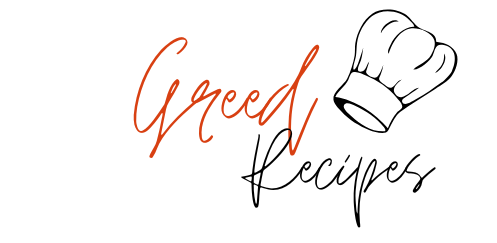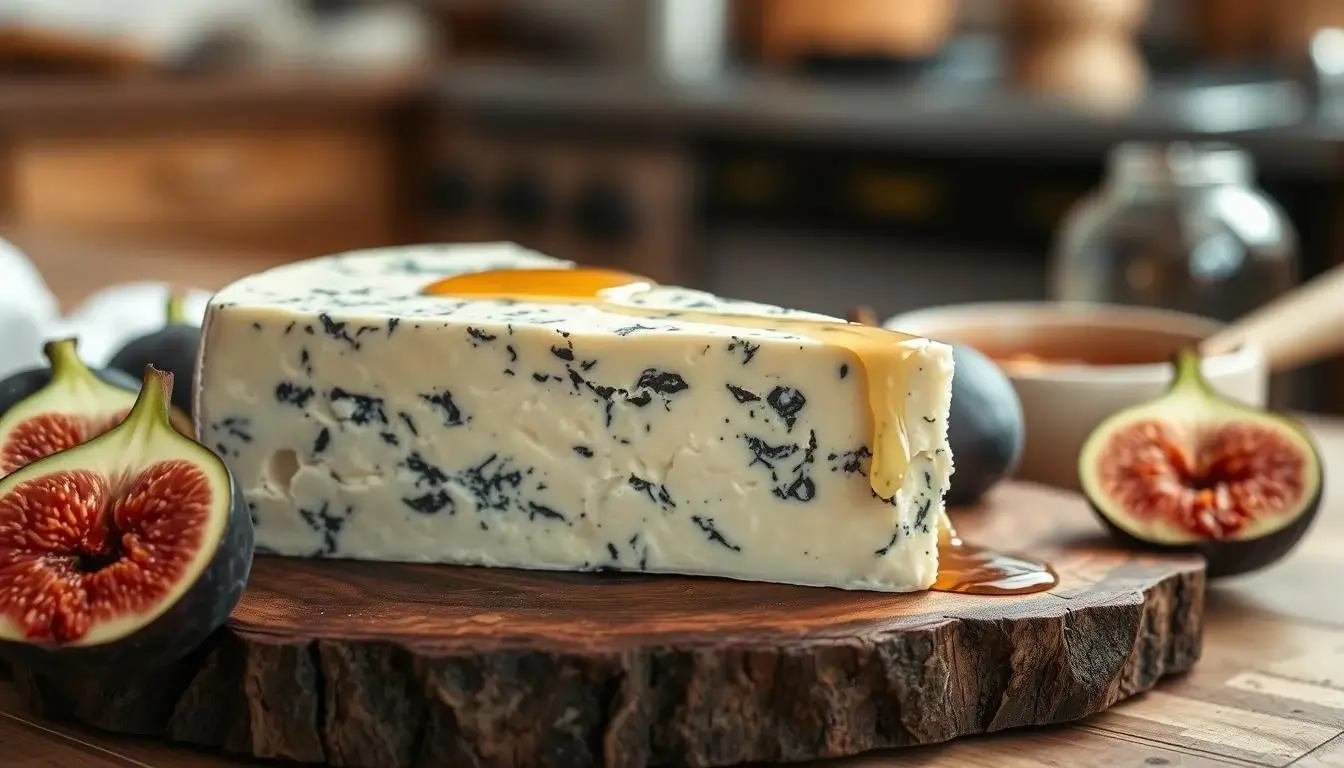Welcome to the world of blue cheese, a cheese that excites food lovers with its bold taste and creamy texture. It’s loved by both experts and newcomers for its tangy flavor. We’ll explore its many uses, origins, types, and health perks. Let’s start our journey together!

Key Takeaways
- Blue cheese boasts a bold flavor profile that appeals to many cheese lovers.
- It’s available in various cheese varieties, each with distinct characteristics.
- Understanding its culinary uses can enhance your cooking experience.
- There are rich historical roots behind the production of blue cheese.
- Blue cheese offers unique health benefits, but moderation is key.
Table of Contents
What is Blue Cheese?
Blue cheese is known for its blue or green veins, thanks to Penicillium mold. It has complex flavors and creamy textures. The type of milk used, like cow, goat, or sheep, adds to its unique taste.
Defining the Unique Characteristics
The smell and taste of blue cheese can be tangy or sharp. Its texture can be crumbly or creamy, depending on aging and mold type. Cheeses like Roquefort and Gorgonzola show how milk and making methods shape the cheese.
History and Origins of Blue Cheese
The history of blue cheese goes back thousands of years. It started in ancient France and Italy. Cheese was key in these cultures, leading to blue cheese’s creation.
Over time, making blue cheese evolved. Today, we use traditional methods. The origins of cheese highlight blue cheese’s role in food history, loved by many for generations.
| Cheese Type | Milk Source | Flavor Profile | Aging Time |
|---|---|---|---|
| Roquefort | Sheep | Sharp, Tangy | 3-6 months |
| Gorgonzola | Cow | Creamy, Earthy | 3-5 months |
| Stilton | Cow | Rich, Nutty | 4-12 months |
Types of Blue Cheese
Exploring blue cheese reveals a world of flavors, textures, and aromas. Each type has its own unique traits, shaped by how it’s made and the molds used. Famous blue cheeses are known for their rich history and the skill in making them.
Famous Varieties of Blue Cheese
Three famous blue cheeses are Roquefort, Stilton, and Gorgonzola. Roquefort from France has a sharp, tangy taste. This is thanks to the moist climate and local molds.
Stilton, from Britain, is creamy and rich, with a crumbly texture. Italian Gorgonzola is milder and sweeter. It’s versatile and used in many dishes.
Regional Differences in Production
Where blue cheese is made affects its taste and texture. Climate, local farming, and recipes play a big role. For example, France’s lush pastures make Roquefort’s milk rich and flavorful.
In England, Stilton’s cooler conditions make it creamy. Knowing these differences shows the art of cheese-making and the cultural heritage of blue cheese.
| Variety | Country of Origin | Flavor Profile | Texture |
|---|---|---|---|
| Roquefort | France | Sharp, tangy | Creamy |
| Stilton | England | Rich, creamy | Crumbly |
| Gorgonzola | Italy | Mild, sweet | Soft |
The Flavor Profile of Blue Cheese
Blue cheese has a complex flavor profile that is both enticing and varied. Each bite offers unique tasting notes, influenced by the type and aging process. It ranges from creamy to tangy, with sharp and spicy notes.
Tasting Notes and Aroma
When you try blue cheese, you’ll find a wide range of flavors. It’s known for:
- Creaminess: A rich feel that covers your tongue.
- Sharpness: A unique taste that can be mild or strong.
- Earthy Notes: Subtle hints that remind you of the cheese’s origin.
- Spicy Undertones: A warm hint, especially in older cheeses.
The aroma is just as enticing, with earthy and spicy scents. These combine to make blue cheese a true delight.
How Aging Affects Flavor
The aging process makes blue cheese even more complex and rich. As it ages, it goes through changes that deepen its flavor. Key factors include:
- Time: Longer aging makes it sharper and earthier.
- Conditions: Humidity and temperature affect how it tastes.
- Mold Variations: Different molds add unique tastes and smells.
Different aging methods create distinct flavors. For example, a six-month-aged blue cheese is different from a year-aged one. This variety lets cheese lovers explore a wide range of tastes.
How Blue Cheese is Made
Blue cheese production is a fascinating journey from milk to the final product. It involves several steps that show the skill of cheesemakers. Each step adds to the unique qualities of blue cheese.
The Cheese-Making Process
The process starts with choosing high-quality milk from cows, goats, or sheep. This milk is pasteurized and cooled. Then, cultures and rennet are added to form curds.
As curds grow, they are cut into small pieces. This lets whey escape. The curds are stirred and cooked until they have the right texture.
After draining the whey, the curds are pressed into molds. This gives the cheese its shape and texture.
Role of Mold in Blue Cheese Production
The mold in blue cheese is key for its flavor and aroma. *Penicillium roqueforti* is used, either during curd formation or injected into the cheese. This mold creates the blue veining and adds to the flavor as it matures.
Aging is done in controlled environments. This lets the mold grow and change the cheese. The temperature and humidity are watched closely to ensure the best aging process.
| Process Step | Description |
|---|---|
| Milk Selection | Choosing high-quality milk from cows, goats, or sheep. |
| Pasteurization | Heating the milk to kill harmful bacteria and then cooling. |
| Curd Formation | Adding cultures and rennet to promote curd development. |
| Cutting and Cooking | Cutting curds into small pieces and cooking to achieve texture. |
| Molding | Shaping curds into molds to form blue cheese. |
| Mold Introduction | Incorporating *Penicillium roqueforti* for veining and flavor. |
| Aging | Storing cheese in controlled environments for flavor maturity. |
Health Benefits of Blue Cheese
Blue cheese is a unique mix of nutrients that can boost your health. It’s known for its creamy texture and strong taste. It also has lots of calcium, protein, and probiotics.
These components are great for your bones, teeth, and gut health. It’s a tasty way to improve your diet.
Nutritional Value Overview
Let’s look at the nutritional benefits of blue cheese:
| Nutrient | Amount per 100g |
|---|---|
| Calories | 353 |
| Protein | 21g |
| Fat | 28g |
| Calcium | 1,130mg |
| Sodium | 1,200mg |
This table shows some key nutrients in blue cheese. It’s a good source of vitamins and minerals.
Potential Health Risks
Blue cheese has many health benefits, but there are risks too. People with mold allergies should avoid it. The molds used in blue cheese can cause allergic reactions.
It also has a lot of sodium, which can be bad for those with high blood pressure or heart issues. Eating too much can harm your health.
Culinary Uses of Blue Cheese
Blue cheese can turn simple dishes into amazing meals. Its bold and tangy taste adds a special touch to many recipes. Adding blue cheese to your dishes can make them more exciting.
Incorporating Blue Cheese into Recipes
Adding blue cheese to your cooking is simple. Here are some creative blue cheese recipes to try:
- Blue Cheese Dressing: Mix crumbled blue cheese with sour cream, mayonnaise, vinegar, and spices for a tasty salad dressing.
- Stuffed Chicken: Stuff chicken breasts with blue cheese, spinach, and herbs before baking for a tasty main dish.
- Blue Cheese Risotto: Add crumbled blue cheese to creamy risotto at the end of cooking for a rich flavor.
- Blue Cheese Pasta: Toss cooked pasta with a sauce of cream, garlic, and melted blue cheese for a delicious meal.
Creative Pairings and Dishes
Blue cheese pairings can inspire new ideas in the kitchen. This versatile cheese goes well with many ingredients, creating tasty combinations. Here are some ideas:
- Fruits: Blue cheese pairs well with pears or figs for a sweet and salty contrast, great for a cheese board.
- Nuts: Walnuts or pecans add a nice crunch with the strong taste of blue cheese.
- Chocolate: Blue cheese can be paired with dark chocolate for a unique, gourmet dessert.
Blue Cheese Pairing Suggestions
Pairing blue cheese with the right wine and food makes it taste even better. It’s all about finding the perfect match. Here are some great options to try.
Wine Pairings for Blue Cheese
For blue cheese, sweet or fortified wines are a classic choice. They balance the cheese’s saltiness. Here are some top picks:
- Port: A sweet ruby or tawny port is a favorite for blue cheese.
- Sauternes: This dessert wine highlights the cheese’s creamy and tangy sides.
- Sherry: A dry sherry pairs well with blue cheese’s richness.
- Riesling: An off-dry Riesling’s sweetness complements the sharp cheese flavors.
Complementary Foods to Enjoy
There are also great foods to pair with blue cheese. Here are some favorites:
- Fruits: Pears, figs, or apples add a sweet touch that balances the cheese.
- Nuts: Walnuts or hazelnuts add crunch and earthiness, boosting the flavor.
- Cured Meats: Prosciutto or salami pair well with blue cheese, offering savory and salty notes.
- Honey: Honey drizzled over blue cheese creates a tasty contrast and enhances the taste.
Storing and Selecting Blue Cheese
Enjoying blue cheese to the fullest means choosing quality and storing it right. With so many varieties, picking the right one is key. Proper storage keeps its flavors and textures perfect, making every bite special.
Tips for Choosing Quality Blue Cheese
Choosing blue cheese needs careful attention. Here are signs of freshness and quality:
- Aroma: A strong, pungent scent is a hallmark of quality blue cheese.
- Color: The veins should be a vibrant blue or green, indicating a robust mold culture.
- Texture: Choose cheese that feels creamy and moist rather than overly dry or crumbly.
- Brand Reputation: Opt for well-known brands with positive reviews in the cheese community.
Proper Storage Techniques
Storing blue cheese right keeps it fresh. Follow these tips:
- Temperature: Store blue cheese in the refrigerator at a temperature between 34°F and 38°F (1°C to 3°C).
- Packaging: Keep it in its original packaging if unopened. Once opened, wrap it in wax paper or parchment for optimal airflow.
- Avoid Plastic Wrap: Do not use plastic wrap, as it traps moisture and can lead to spoilage.
- Separate Storage: Keep blue cheese away from strong-smelling foods to prevent absorption of unwanted flavors.
Blue Cheese in Popular Culture
Blue cheese has made a big splash in popular culture. It has shaped both food traditions and how it’s shown in media. Its bold flavors and unique taste have made it a favorite in gourmet settings.
As chefs use it in fancy recipes, blue cheese has become a big part of dining. It shows how tastes are changing and what people want to eat.
Influence on Food Trends
Blue cheese has inspired new dishes, like sauces and dressings. It’s a key ingredient in fancy restaurant menus. Chefs love its complex taste, showing off their skills.
This trend also shows a love for handmade and local foods. It links blue cheese to today’s food trends.
Cameos in Media and Literature
Blue cheese has also appeared in movies and books. It’s often seen as a sign of class, showing off a character’s taste. This adds to the idea of blue cheese as a sign of luxury.
In books, it’s linked to enjoying good food and exploring new tastes. These mentions make blue cheese more than just a food. It’s seen as a part of a refined lifestyle.
Exploring Gourmet Blue Cheese
Gourmet blue cheese is loved by cheese fans worldwide. It’s made with care and has special flavors. Artisan blue cheese makers are key to this tasty world. They mix old cheese-making ways with new ideas, making amazing cheeses.
Artisan Producers to Know
Some cheese makers are famous for their blue cheeses. They’re known for their skills and the top-notch ingredients they use. Companies like Rogue Creamery and Point Reyes Farmstead Cheese Company focus on being green.
They make small batches that show off their area’s taste. Their hard work has won them fans and awards.
Unique Flavor Combinations
Trying different blue cheese flavors is exciting. Some makers mix blue cheese with things like truffle oil or fig. This makes for amazing tastes.
Working with other food makers adds even more fun. They team up with local wines, breads, or meats. This makes blue cheese the main attraction in fancy dishes.
Conclusion
Exploring blue cheese is a journey filled with rich flavors and unique varieties. We’ve looked at how it’s made and the passion behind it. Each type of blue cheese has its own story and taste, inviting you to try new things.
Blue cheese adds excitement to cooking, whether in gourmet recipes or with wine. It makes every dish memorable. Feel free to try new ways of using it to bring out its bold flavors.
Blue cheese is more than a food; it’s an adventure for your taste buds. From ancient times to today, it’s a key ingredient in many dishes. Let’s enjoy and share our love for blue cheese in every meal we make.
FAQ
What is blue cheese and why is it unique?
Blue cheese is known for its bold flavors and blue or green veins. It comes from cow, goat, or sheep milk. This makes it a hit among cheese lovers for its unique taste.
What are the most popular varieties of blue cheese?
Famous types include Roquefort, Stilton, and Gorgonzola. Each has its own taste and making method, shaped by its region.
How does the aging process affect blue cheese flavor?
Aging makes blue cheese creamier and sharper. It develops earthy and spicy smells. This enhances the taste in cooking.
What health benefits does blue cheese offer?
Blue cheese is full of calcium, protein, and probiotics. These can help your gut. But, eat it in small amounts because of high sodium and possible allergies.
How can I incorporate blue cheese into my cooking?
Blue cheese is versatile. Use it in salads, dressings, or pasta. It also works in desserts and sauces for a bold twist.
What foods pair well with blue cheese?
Blue cheese goes well with fruits, nuts, and meats. These pairings make it a great addition to any dish.
How should I store blue cheese to maintain its quality?
Wrap blue cheese in wax or parchment paper. Then, store it in an airtight container in the fridge. This keeps it fresh and flavorful.
Where can I find gourmet blue cheese?
Look for gourmet blue cheese at local cheese shops or farmers’ markets. These places offer unique flavors and show off the art of cheese-making.
How does blue cheese impact popular culture?
Blue cheese is a trend in fine dining and is seen in movies and TV. It’s seen as a sophisticated choice.
What signs indicate quality blue cheese when selecting?
Quality blue cheese has clear veins, a moist texture, and a nice smell. Choose from trusted brands or makers known for their skill.
Visit our Instagram page

